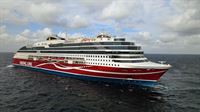Climate-smart Viking Glory is also a flagship for sustainability

Waste heat from the vessel’s engines is converted into electricity, while waste cold from liquefied natural gas is used for cooling. Its hull minimizes water resistance, and an intelligent automated control system turns off air conditioning in empty cabins. The new Viking Glory’s innovative solutions make it one of the world’s most climate-smart passenger ships.
When Viking Glory is launched in service in March, the environmental impact of Viking Line’s vessels on the Turku–Mariehamn–Stockholm route will be further reduced. For example, Viking Glory has 66 per cent more cargo capacity than Amorella but is expected to produce more than 25 per cent fewer emissions than its predecessor. Viking Glory and Viking Grace, which began serving the route in 2013, are now the two most climate-smart vessels sailing the Baltic Sea.
“Efficiency, environmental requirements and the future were all taken into consideration in an entirely new way when Viking Glory was planned. Our flagship has been built as a tribute to our roots – that is, the Baltic Sea and the nature in its beautiful archipelagos. Most of our sustainability work involves different solutions that passengers don’t notice, like the vessel’s technical solutions, which have seen rapid advances. Ten years ago, Grace was the world’s most environmentally-friendly passenger ship and now Glory, which is bigger, will use about ten per cent less fuel,” says Viking Line’s sustainability manager, Dani Lindberg.
“Glory’s Azipod propellers and other technical innovations save considerable time in port, which gives us leeway in terms of keeping to the timetable. Every minute saved in port results in fewer emissions during the sea journey. We also do daily route planning, which means we modify our journey based on weather conditions and timetables.”
However, being climate-smart is not just the privilege of Viking Line’s newest vessel. The company is developing its other vessels so that they are more energy-efficient throughout their life cycle: the steering and air conditioning systems are being updated, new technology is installed each year, and even the hull can be modified to reduce resistance. Divers regularly scrub the bottoms of the vessels to reduce water resistance and fuel consumption. As a result, no toxic bottom paints are needed.
“The vessels’ energy consumption and emissions will continue to be reduced going forward. The development of new fossil-free fuels and energy storage is proceeding at full speed, and we are closely monitoring these advances. We will be taking part in various trials and projects, for instance, testing new clean tech innovations and clean fuels,” notes Dani Lindberg.
These aspects make Viking Glory a climate-smart vessel:
Engines that run on totally sulphur-free liquefied natural gas. Viking Glory is one of the first vessels in the world to use Wärtsilä’s 31DF dual-fuel engines and run on liquefied natural gas (LNG). They enable optimization of fuel use but produce no sulphur emissions at all. Furthermore, they produce fewer carbon dioxide emissions than do diesel engines.
“When Viking Grace started running on liquefied natural gas, sulphur and particulate matter emissions were reduced by 85 per cent while greenhouse gas emissions were reduced by 15 per cent compared to oil. Like Grace, Glory will also run on biogas or synthetic fuels produced using renewable energy when these are available in the future,” says Viking Glory’s captain, Ulf Lindroos.
Azipod rotor propeller system. With ABB’s propeller system, it is easier to turn in port, and manoeuvring the vessel takes less time and fuel.
Optimal hull design. By using the Azipod system, it was possible to plan Viking Glory so that resistance when the vessel is operating is about 8 per cent less than for a vessel with a traditional propeller. The hull design reduces the formation of waves as well as fuel consumption.
Engine waste heat is converted into electricity. Viking Glory has been equipped with an energy recovery system from Climeon that converts waste heat from its engines into electricity. The system is expected to generate a full 40 per cent of the electricity needed for the vessel’s passenger functions.
Waste cold is utilized to chill cold stores. The new vessel is also a pioneer in making use of cold waste from LNG. Cold waste is used in refrigeration facilities and cold stores.
More cargo capacity. Viking Glory has 66 per cent more cargo capacity than its predecessor Amorella and 17 per cent more than Viking Grace. “The two climate-smart Turku-based vessels – Glory and Grace – make totally new, greener cargo transport on the Baltic Sea possible,” says Captain Ulf Lindroos.
Dynamic control system for air conditioning and lighting. On Viking Glory, lights are turned off automatically in empty rooms, while air conditioning and heat are turned down automatically. The dynamic control system is directly connected to the booking system.
Even more efficient recycling. On board Viking Line’s vessels, great focus is placed on recycling – and that is also the case for Viking Glory.
“We recycle glass packaging, scrap metal, paper and cardboard. Recycling the metal in cans uses 75 per cent less energy compared to producing new iron ore. On board Glory, food waste is also collected and used in biogas production,” says sustainability manager Dani Lindberg.
Combatting food waste in the restaurants. Reducing food waste on the vessels is something employees work with every day on board. For example, the buffet restaurants offer portioned-size servings while sandwiches in the cafés are prepared to order based on actual demand. Menus are adjusted depending on access to ingredients, and locally produced and sustainable alternatives are always on offer when possible.
Read more about Viking Glorys technology
For further information:
Dani Lindberg, Sustainability Manager
dani.lindberg@vikingline.com, tel. +358 18 27 000
Johanna Boijer-Svahnström, Senior Vice President, Corporate Communications
johanna.boijer@vikingline.com, tel. +358 18 270 00
Christa Grönlund, Communications Manager
christa.gronlund@vikingline.com, tel. +358 9 123 51





